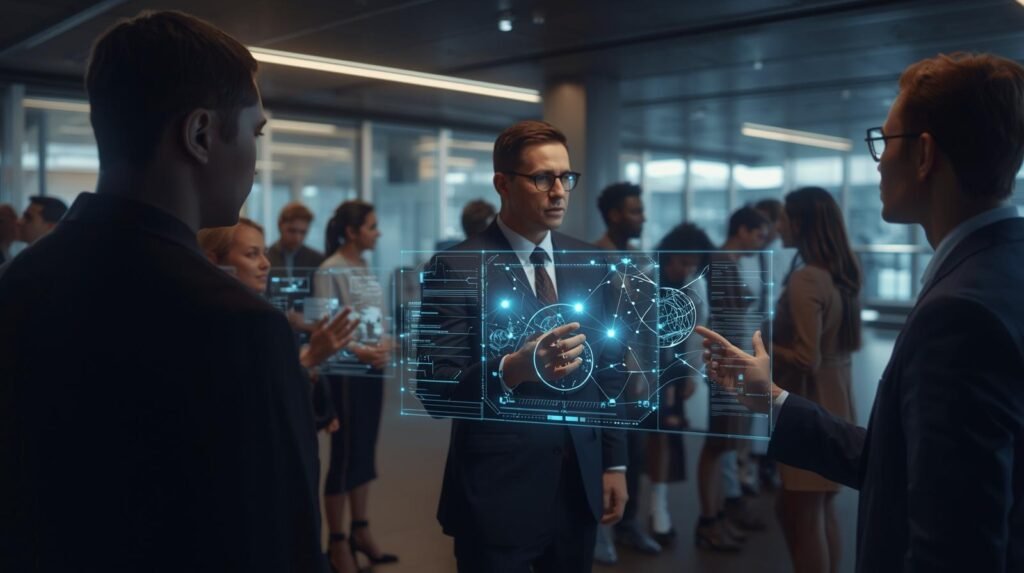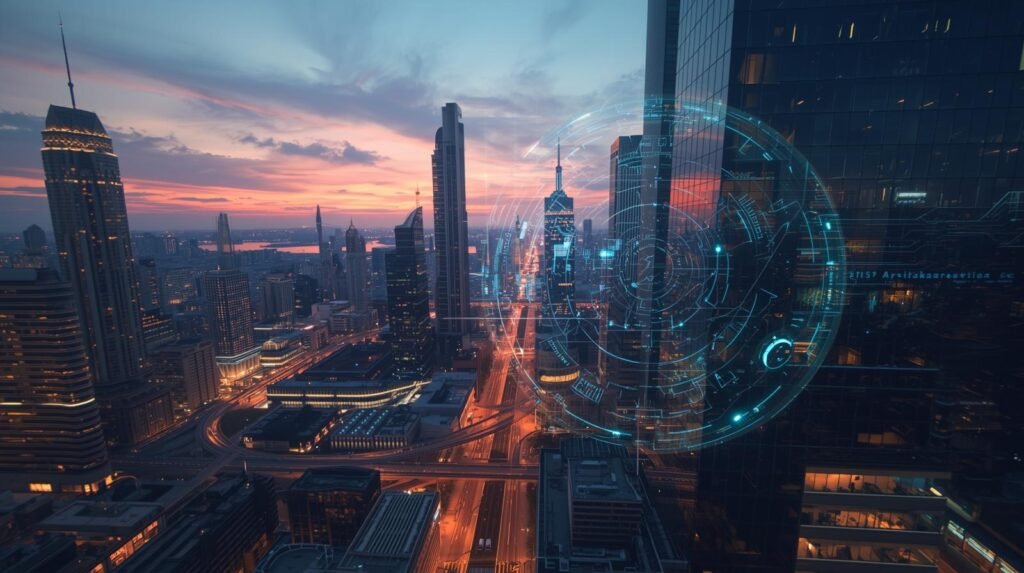
In just a few short years, Artificial Intelligence (AI) has moved from being a futuristic concept in sci-fi movies to an everyday reality shaping how we live, work, and think. Whether it’s the personalized recommendations on Netflix, voice assistants like Alexa and Siri, self-driving cars, or tools that can generate art and write code — AI has already woven itself into the fabric of our modern lives.
The question is no longer “Is AI coming?” It’s “How far will it go — and how will it change everything?”
Let’s take a deep dive into how AI is transforming our world today, what it means for different industries, and how we can prepare for the intelligent future that’s already here.
1. Understanding AI: From Concept to Reality
Artificial Intelligence is not a single technology — it’s a collection of systems that allow machines to perform tasks that traditionally required human intelligence. These include learning, reasoning, problem-solving, understanding language, and perception.
AI can be divided into three categories:
- Narrow AI – Focused on specific tasks, like chatbots, recommendation systems, or spam filters.
- General AI – Machines that can think and learn like humans (still in theory and research).
- Super AI – A level beyond human intelligence — a concept that sparks both excitement and fear in experts.
Today’s world runs on Narrow AI, but even that has been powerful enough to revolutionize almost every industry.
2. AI in Everyday Life
You might not realize it, but you interact with AI dozens of times every day. From the moment you unlock your phone with facial recognition to the instant you scroll through Instagram or YouTube — algorithms are at work.
a. Personal Assistants
Virtual assistants like Siri, Alexa, and Google Assistant use Natural Language Processing (NLP) to understand and respond to voice commands. They can control smart homes, set reminders, and even engage in small talk.
b. Recommendation Systems
Netflix suggesting the next movie, Spotify curating a playlist, or Amazon showing products you might like — all these are powered by machine learning algorithms that analyze your preferences and behaviors.
c. Smart Devices
AI is at the heart of smart home technologies — from thermostats that learn your schedule to fridges that suggest recipes based on what’s inside. These devices make life more convenient, efficient, and connected.
d. Social Media
Platforms like Facebook, Instagram, and TikTok rely heavily on AI for content moderation, facial recognition, and personalized feeds. The algorithms learn your behavior to deliver content tailored specifically for you — keeping you scrolling longer.
3. AI in Healthcare: Saving Lives with Data
One of the most profound transformations driven by AI is happening in healthcare.
AI’s ability to analyze massive datasets allows doctors to diagnose diseases faster and more accurately. Machine learning models can detect patterns in X-rays, MRIs, and CT scans that even the most trained human eyes might miss.
Key applications:
- Early Diagnosis: AI algorithms can identify signs of cancer, heart disease, and diabetic retinopathy earlier than ever before.
- Drug Discovery: What used to take years can now be done in months, as AI simulates how new compounds will interact with the human body.
- Virtual Nursing Assistants: Chatbots and AI systems help monitor patients and remind them to take medications.
- Predictive Analytics: Hospitals use AI to forecast patient admissions, optimize resources, and prevent medical errors.
In short, AI isn’t replacing doctors — it’s empowering them to make better, faster, and more accurate decisions.
4. AI in Education: Personalized Learning for Every Student
Traditional education treats every student the same. AI changes that.
Through adaptive learning systems, AI can analyze a student’s strengths, weaknesses, and pace, then customize learning materials to match their needs. Tools like Coursera, Khan Academy, and Duolingo already use AI to make learning interactive and personalized.
Impact of AI in Education:
- Individualized Learning: Each student gets a customized learning experience.
- Smart Content: AI can generate digital textbooks, quizzes, and even virtual simulations.
- Automated Grading: Teachers can save time on grading so they can focus more on mentoring.
- 24/7 Tutoring: AI chatbots can assist students anytime, anywhere.
The result? Education becomes more accessible, efficient, and engaging.
5. AI in Business: The Era of Intelligent Operations
In the business world, AI has become the ultimate productivity booster.
From customer service chatbots to predictive analytics that guide marketing strategies, AI helps companies save time, reduce costs, and make better decisions.
Applications in Business:
- Customer Support: AI chatbots like ChatGPT-based systems offer instant responses 24/7.
- Marketing Automation: AI analyzes customer data to predict behavior, personalize ads, and increase conversions.
- Sales Forecasting: Businesses use AI to predict demand and manage inventory efficiently.
- Fraud Detection: AI-powered systems detect unusual patterns in transactions, protecting businesses and consumers.
Companies like Google, Amazon, Tesla, and IBM are already leveraging AI to dominate their markets — and even small businesses can now access these tools through affordable cloud services.

6. AI in Transportation: Driving into the Future
Imagine cars that never get tired, drunk, or distracted. That’s the promise of AI in transportation.
Autonomous Vehicles
Companies like Tesla, Waymo, and Uber are developing self-driving technologies that use AI, sensors, cameras, and radar to navigate roads safely.
Smart Traffic Management
Cities are implementing AI systems to monitor traffic patterns, reduce congestion, and predict maintenance needs.
Logistics & Delivery
AI optimizes delivery routes, predicts shipment delays, and reduces fuel consumption — saving time, money, and the environment.
The transportation industry is heading toward a fully automated ecosystem, making travel safer, faster, and more sustainable.
7. AI in Finance: Smarter Money Management
The financial sector is one of the earliest adopters of AI — and for good reason. The ability to process enormous datasets in real-time allows banks, insurers, and investors to make smarter decisions.
AI in Action:
- Fraud Detection: Machine learning models identify suspicious transactions instantly.
- Algorithmic Trading: AI predicts stock movements and executes trades faster than humans.
- Credit Scoring: AI assesses loan eligibility using alternative data points, making credit accessible to more people.
- Personal Finance Apps: Tools like CleO or MoneyLion analyze spending habits and provide budgeting advice.
By eliminating human bias and increasing efficiency, AI is making financial systems more reliable and transparent.
8. AI in Entertainment: Creativity Reimagined
From music composition to film production, AI is redefining creativity itself.
- Content Generation: AI can write scripts, compose music, and even generate artwork in seconds.
- Visual Effects: AI automates editing and enhances graphics in movies and games.
- Personalized Experiences: Streaming platforms use AI to recommend shows and music tailored to your mood.
Even creators are now using AI tools like ChatGPT, Midjourney, DALL-E, and Runway ML to brainstorm ideas, create visuals, and speed up production.
The line between human and machine creativity is blurring — and it’s creating a new era of digital art.
9. AI in Agriculture: Feeding the World Efficiently
Feeding 8 billion people sustainably is one of humanity’s biggest challenges. AI is helping farmers achieve more with less.
Applications:
- Precision Farming: AI-powered drones and sensors monitor soil health, water usage, and crop growth.
- Predictive Analytics: Algorithms forecast weather patterns and pest outbreaks.
- Automated Harvesting: Robots can pick fruits and vegetables efficiently without damaging them.
By combining AI, IoT, and robotics, agriculture is becoming more efficient, sustainable, and resilient to climate change.
10. AI and the Future of Work
One of the biggest concerns around AI is its impact on jobs. Many fear that automation will replace human workers.
While some jobs will indeed disappear, history shows that technological revolutions create new opportunities. AI will eliminate repetitive tasks but open doors to creative, analytical, and strategic roles.
Jobs at Risk:
- Data entry clerks
- Telemarketers
- Cashiers
- Basic manufacturing roles
Jobs on the Rise:
- AI engineers and data scientists
- Machine learning specialists
- AI ethicists and compliance officers
- Prompt engineers and creative technologists
The key lies in upskilling and adaptability. Workers who learn to collaborate with AI will thrive in the new digital economy.
11. AI Ethics and the Need for Responsible Innovation
As AI becomes more powerful, ethical considerations are becoming critical.
Issues like data privacy, algorithmic bias, surveillance, and misinformation are raising important questions. Who owns the data? How do we ensure AI is fair and transparent? What happens when machines make mistakes?
Tech giants and governments worldwide are now working on AI ethics frameworks to ensure responsible innovation. The European Union’s AI Act and initiatives like the “AI for Good” movement by the UN are leading examples.
Ethical AI is not just a moral obligation — it’s essential for trust and long-term progress.
12. AI in Developing Countries: Bridging the Global Gap
AI isn’t just transforming wealthy nations. It’s also creating opportunities in developing countries by solving real-world problems.
- In India, AI is used to predict crop yields, assist in telemedicine, and improve financial inclusion.
- In Africa, AI-driven platforms help farmers detect plant diseases using smartphone photos.
- In Southeast Asia, chatbots assist with digital education and microloans.
AI can be the great equalizer — if made accessible and affordable for everyone.
13. The Dark Side of AI: Challenges and Risks
Despite its immense benefits, AI also carries significant risks if left unchecked.
a. Job Displacement
Automation could displace millions of workers in manufacturing and service industries.
b. Bias and Discrimination
AI systems trained on biased data can unintentionally perpetuate inequality.
c. Deepfakes and Misinformation
AI-generated fake videos and content can manipulate public opinion, posing threats to democracy.
d. Privacy Concerns
AI-driven surveillance systems can invade privacy and create mass monitoring.
To tackle these issues, transparency, accountability, and regulation are crucial. We must ensure that AI serves humanity — not the other way around.
14. The Future: Human + AI Collaboration
The next era will not be about humans versus machines. It will be about humans working with machines.
AI can handle repetitive, data-heavy tasks, while humans bring creativity, empathy, and ethics. Together, they can achieve things neither could alone.
Imagine:
- Doctors diagnosing with AI precision.
- Teachers supported by AI tutors.
- Artists creating with AI inspiration.
- Businesses powered by AI analytics.
The true power of AI lies not in replacing us — but in augmenting human intelligence.
15. Preparing for the AI Future
The AI revolution isn’t coming — it’s already here. The question is: are we ready for it?
Here’s how we can prepare:
- Learn continuously: Stay updated on AI tools and trends.
- Focus on creativity and critical thinking: Machines can’t replicate human imagination.
- Adopt a growth mindset: View AI as an ally, not a threat.
- Support ethical AI: Advocate for transparency and fairness in AI systems.
- Invest in digital literacy: Equip the next generation with AI education.
The future belongs to those who can adapt, learn, and innovate in collaboration with intelligent machines.
16. Conclusion: The Future is Now
Artificial Intelligence has already begun reshaping every aspect of our lives — from the way we shop to the way we learn, heal, and connect. It’s making our world smarter, faster, and more efficient, while also challenging us to think deeply about what it means to be human.
The future isn’t something we’re waiting for — it’s something we’re creating right now.
AI is not just a tool of technology; it’s a mirror reflecting our creativity, intelligence, and ethics as a species.
As we stand on the edge of this new era, one truth is clear:
The future is not AI vs. humans — it’s AI with humans.
And together, we can build a world that’s not just intelligent — but truly wise.